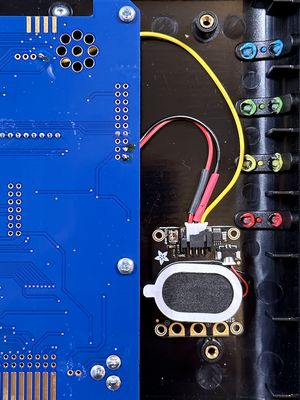Beeper (hardware): Difference between revisions
Added note on low DAC volume and need for even more powerful amps. Clarified boot rom options. |
m Added heading to clarify that the speaker mod is for KS1 Nexts only |
||
| Line 4: | Line 4: | ||
The buzzer should be approximately 1 inch diameter with impedance of 16 ohm (which should equate to a basic 'PC BIOS' piezo type speaker). J3 pins 1 and 2 are negative, pins 3 and 4 are positive. | The buzzer should be approximately 1 inch diameter with impedance of 16 ohm (which should equate to a basic 'PC BIOS' piezo type speaker). J3 pins 1 and 2 are negative, pins 3 and 4 are positive. | ||
=== Increasing Speaker Volume === | |||
'''This modification only works on Kickstarter 1 (= Issue 2B) Nexts. It is ''not'' for Kickstarter 2 (= Issue 4) boards.''' | |||
On the Issue 2B boards, [https://www.specnext.com/forum/viewtopic.php?t=1860&hilit=beeper many users found the above speaker too quiet]. For higher volume levels, use an integrated amplifier/speaker board like the [https://www.adafruit.com/product/3885 Adafruit STEMMA Speaker] instead. A [https://www.adafruit.com/product/3893 3-pin JST PH 2.0 mm female header cable] makes disconnecting it again easy. | On the Issue 2B boards, [https://www.specnext.com/forum/viewtopic.php?t=1860&hilit=beeper many users found the above speaker too quiet]. For higher volume levels, use an integrated amplifier/speaker board like the [https://www.adafruit.com/product/3885 Adafruit STEMMA Speaker] instead. A [https://www.adafruit.com/product/3893 3-pin JST PH 2.0 mm female header cable] makes disconnecting it again easy. | ||
With the right settings (see below), this will give you roughly original ZX Spectrum sound levels, though | With the right settings (see below), this will give you roughly original ZX Spectrum sound levels, though '''only for the beeper used in the classic ZX Spectrum 16/48k'''. AY sound volume on 128k games like Dizzy 6 or Next games like Baggers In Space is still fairly low but serviceable in a quiet environment. DAC sound (like in the TX-1696 demo) remains too quiet to be usable; use HDMI or the 3.5 mm audio jack instead. To use an internal speaker with those types of audio, you will need a more powerful speaker and amplifier board (and possibly some way to adjust its volume as you switch between audio types). | ||
[[File:ZX-Spectrum-Next-Internal-Adafruit-Speaker-Amplifier.jpg|thumb|center|An Adafruit STEMMA Speaker with integrated amplifier connected to the Spectrum Next Issue 2B motherboard and held in place inside the case with self-adhesive velcro strips. Cable colors do not reflect GND and Vcc correctly, but the cable sleeves do.]] | [[File:ZX-Spectrum-Next-Internal-Adafruit-Speaker-Amplifier.jpg|thumb|center|An Adafruit STEMMA Speaker with integrated amplifier connected to the Spectrum Next Issue 2B motherboard and held in place inside the case with self-adhesive velcro strips. Cable colors do not reflect GND and Vcc correctly, but the cable sleeves do.]] | ||
Latest revision as of 16:01, 19 February 2024
The Spectrum Next can create sound using Turbo Sound Next (3 AY-3-8912 sound chips) controlled by the BASIC PLAY keyword and the signal from these goes to the HDMI port or the 'ear' socket. Additionally an internal speaker can be connected which will generate sound in the same manner as the original 48k Spectrum, controlled via the BEEP keyword, which will also output via HDMI/ear.
A speaker attaches to connector J3 on the circuit board and requires a 2.54mm Pitch, 4 Way, 1 Row through-hole pin header. If you're fitting the board inside an original rubber key case, you'll probably need a right-angled connector due to the height required.
The buzzer should be approximately 1 inch diameter with impedance of 16 ohm (which should equate to a basic 'PC BIOS' piezo type speaker). J3 pins 1 and 2 are negative, pins 3 and 4 are positive.
Increasing Speaker Volume
This modification only works on Kickstarter 1 (= Issue 2B) Nexts. It is not for Kickstarter 2 (= Issue 4) boards.
On the Issue 2B boards, many users found the above speaker too quiet. For higher volume levels, use an integrated amplifier/speaker board like the Adafruit STEMMA Speaker instead. A 3-pin JST PH 2.0 mm female header cable makes disconnecting it again easy.
With the right settings (see below), this will give you roughly original ZX Spectrum sound levels, though only for the beeper used in the classic ZX Spectrum 16/48k. AY sound volume on 128k games like Dizzy 6 or Next games like Baggers In Space is still fairly low but serviceable in a quiet environment. DAC sound (like in the TX-1696 demo) remains too quiet to be usable; use HDMI or the 3.5 mm audio jack instead. To use an internal speaker with those types of audio, you will need a more powerful speaker and amplifier board (and possibly some way to adjust its volume as you switch between audio types).

Solder GND to J15 pin 20, Vcc to J15 pin 19, and the signal input to J3 pin 4 (next to the speaker holes on the Next PCB). Attach the speaker board to the Next case using two pieces of self-adhesive velcro. Place it next to the PCB and near the ZX Spectrum Expansion Connector. See the photo above.
Remove the Expansion Connector cover for more volume, and turn the potentiometer on the speaker board all the way up.
Turn on your Next while holding down SPACE to enter the TBBlue boot ROM menu. Here, toggle BEEPer to Int to increase its volume to roughly match the original ZX Spectrum for classic 16/48k "beeper" games (AY and DAC sound will not play through the internal speaker in this case). You can also disable the internal speaker here.